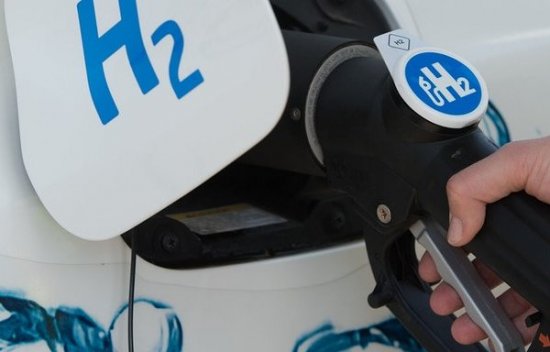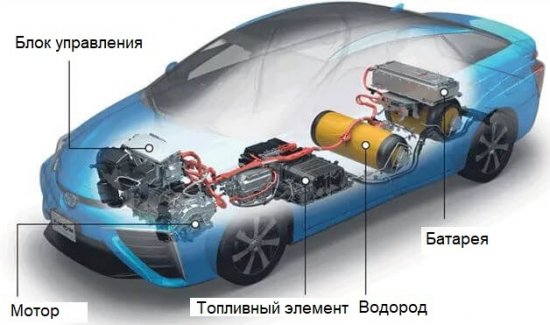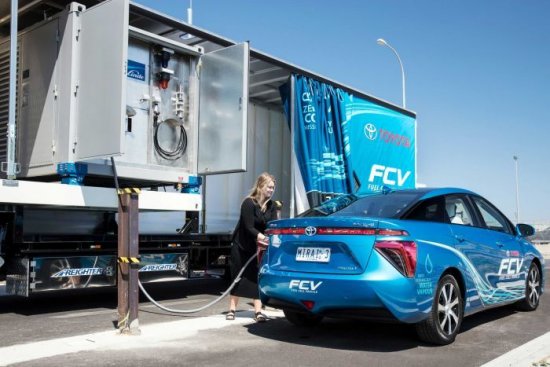Trends and prospects for hydrogen fuel cells for clean transportation
This article will focus on hydrogen fuel cells, trends and prospects for their application. Hydrogen-based fuel cells are attracting increasing attention in the automotive industry today, because if the 20th century was the century of the internal combustion engine, then the 21st century may become the century of hydrogen energy in the automotive industry. . Already today, thanks to hydrogen cells, spaceships work, and in some countries of the world, hydrogen has been used for more than 10 years to generate electricity.
A hydrogen fuel cell is an electrochemical device like a battery that generates electricity through a chemical reaction between hydrogen and oxygen, and the product of the chemical reaction is pure water, while burning natural gas, for example, produces environmentally harmful carbon dioxide.
In addition, hydrogen cells can operate with higher efficiency, which is why they are particularly promising. Imagine efficient, environmentally friendly car engines.But the entire infrastructure is currently built and specialized for petroleum products, and the large-scale introduction of hydrogen cells in the automotive industry faces this and other obstacles.
Meanwhile, since 1839 it has been known that hydrogen and oxygen can combine chemically and thereby obtain an electric current, that is, the process of electrolysis of water is reversible — this is a confirmed scientific fact. Already in the 19th century, fuel cells began to be studied, but the development of oil production and the creation of the internal combustion engine left hydrogen energy sources and they became something exotic, unprofitable and expensive to produce.
In the 1950s, NASA was forced to resort to hydrogen fuel cells, and then out of necessity. They needed a compact and efficient power generator for their spacecraft. As a result, Apollo and Gemini flew into space on hydrogen fuel cells, which turned out to be the best solution.
Today, fuel cells are completely out of experimental technology, and in the last 20 years significant progress has been made in their wider commercialization.
It is not in vain that high hopes are placed on hydrogen fuel cells. In the process of their work, environmental pollution is minimal, technical advantages and safety are obvious, in addition, this type of fuel is fundamentally autonomous and is able to replace heavy and expensive lithium batteries.
The fuel of a hydrogen cell is converted into energy directly in the course of a chemical reaction, and here more energy is obtained than with conventional combustion.It consumes less fuel and the efficiency is three times higher than that of a similar device using fossil fuels.
The efficiency will be the higher, the better organized the way of utilizing the water and heat generated during the reaction. Emissions of harmful substances are minimal, since only water, energy and heat are released, while even with the most successfully organized process of burning traditional fuel, nitrogen oxides, sulfur, carbon and other unnecessary combustion products are inevitably formed.
In addition, conventional fuel industries themselves have a detrimental effect on the environment, and hydrogen fuel cells avoid a dangerous invasion of the ecosystem, since the production of hydrogen is possible from completely renewable energy sources. Even the leakage of this gas is harmless, as it evaporates instantly.
The fuel cell does not matter from which fuel hydrogen is obtained for its operation. The energy density in kWh / l will be the same, and this indicator is constantly increasing with the improvement of the technology for creating fuel cells.
The hydrogen itself can be obtained from any convenient local source, whether it is natural gas, coal, biomass or electrolysis (through wind, solar energy, etc.) Dependence on regional electricity suppliers disappears, the systems are usually independent of electric networks.
The operating temperatures of the cell are quite low and can vary from 80 to 1000 ° C, depending on the type of element, while the temperature in a conventional modern internal combustion engine reaches 2300 ° C.The fuel cell is compact, emits a minimum of noise during generation, has no emissions of harmful substances, so it can be placed in any convenient place in the system in which it works.
In principle, not only electricity, but also the heat that is released during a chemical reaction can be used for useful purposes, for example for heating water, space heating or cooling - with this approach, the efficiency of generating energy in a cell will approached 90%.
The cells are sensitive to changes in load, so as power consumption increases, more fuel must be supplied. This is similar to how a gasoline engine or internal combustion generator works. Technically, the fuel cell is implemented quite simply, since there are no moving parts, the design is simple and reliable, and the probability of failure is fundamentally extremely small.
A hydrogen-oxygen fuel cell with a proton exchange membrane (for example «with a polymer electrolyte») contains a membrane conducting protons from a polymer (Nafion, polybenzimidazole, etc.), which separates two electrodes - an anode and a cathode. Each electrode is usually a carbon plate (matrix) with a supported catalyst—platinum or an alloy of platinoids and other compounds.
On the anode catalyst, molecular hydrogen dissociates and loses electrons. Hydrogen cations are transported across the membrane to the cathode, but electrons are donated to the external circuit because the membrane does not allow electrons to pass through. On the cathode catalyst, the oxygen molecule combines with an electron (which is supplied by external communications) and an incoming proton and forms water, which is the only product of the reaction (in the form of steam and / or liquid).
Yes, electric cars today run on lithium batteries. However, hydrogen fuel cells can replace them. Instead of a battery, the power source will support much less weight. In addition, the power of the car can be increased not at all due to the increase in weight due to the addition of battery cells, but simply by adjusting the supply of fuel to the system while it is in the cylinder. Therefore, car manufacturers have high expectations for hydrogen fuel cells.
More than 10 years ago, work on the creation of hydrogen cars began in many countries around the world, especially in the USA and Europe. Oxygen can be extracted directly from atmospheric air using a special filtering compressor unit located on board the vehicle. Compressed hydrogen is stored in a heavy-duty cylinder under a pressure of about 400 atm. Refueling takes a few minutes.
The concept of environmentally friendly urban transport has been applied in Europe since the mid-2000s: such passenger buses have long been found in Amsterdam, Hamburg, Barcelona and London. In a metropolis, the absence of harmful emissions and reduced noise are extremely important. The Coradia iLint, the first hydrogen-powered railway passenger train, launched in Germany in 2018. By 2021, 14 more such trains are planned to be launched.
Over the next 40 years, the shift to hydrogen as the primary energy source for cars could revolutionize the world's energy and economy. Although it is now clear that oil and gas will remain the main fuel market for at least another 10 years.Nevertheless, some countries are already investing in the creation of vehicles with hydrogen fuel cells, despite the fact that many technical and economic barriers need to be overcome.
Creating hydrogen infrastructure, safe gas stations is the main task, because hydrogen is an explosive gas. Either way, with hydrogen, vehicle fuel and maintenance costs can be significantly reduced and reliability can be increased.
According to Bloomberg forecasts, by 2040 cars will consume 1,900 terawatt hours instead of the current 13 million barrels per day, which will be 8% of electricity demand, while 70% of the oil produced in the world today goes to the production of transportation fuel . Of course, at this point, the prospects for the battery electric vehicle market are much more pronounced and impressive than in the case of hydrogen fuel cells.
In 2017, the electric vehicle market was $17.4 billion, while the hydrogen car market was valued at just $2 billion. Despite this difference, investors continue to be interested in hydrogen energy and finance new developments.
Thus, in 2017, the Hydrogen Council was created, which includes 39 major car manufacturers such as Audi, BMW, Honda, Toyota, Daimler, GM, Hyundai. Its purpose is to research and develop new hydrogen technologies and their subsequent widespread distribution.



